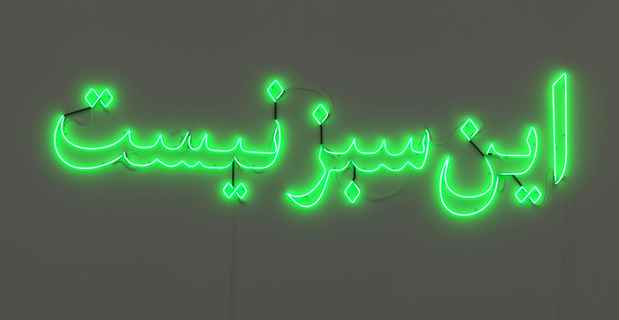“CALLIGRAFFITI: 1984-2013” Exhibition
Leila Heller Gallery (Chelsea)

This event has ended.
Originally curated in 1984 by Jeffrey Deitch (Director, Museum of Contemporary Art, Los Angeles) at Leila Heller’s former uptown gallery, Calligraffiti explored a myriad of possible connections shared between the seemingly disparate styles of select mid-century abstract, U.S. graffiti, and calligraphic artists from the Middle East and its diaspora.
By presenting an expanded and updated roster of artists including site-specific installations by emerging and established artists 30 years later, Calligraffiti 1984/2013 re-examines the global impact of graffiti and calligraphy as converging modes of personal expression, popular culture, and political dissent mutually grounded in arrogating the systems of language. Featuring more than 50 works by artists ranging from Jackson Pollock and Lee Krasner; Keith Haring and Jean-Michel Basquiat, and Hossein Zenderoudi and Pouran Jinchi, the exhibition will also include site-specific installations by emerging and established artists such as eL Seed and LA2.
Since ancient times, calligraphers and scribes have visually transcribed concepts surrounding Divine Infinity by presenting the written word as art. In modern times, movements ranging from Dada, Surrealism, Tachism, and Abstract Expressionism have all incorporated elements of writing and language into their abstractions. Most recently, contemporary artists such as Hossein Zenderoudi, Parviz Tanavoli, Hadieh Shafie, and Pouran Jinch, whose work will be on view, have transformed traditional Arabic script in order to create new abstract shapes and gestural marks, augmented by color, poetry, rhyme, or ayat (Qoranic verse), which bridge distinctions between nationalities, generations, and beliefs. As a means of political propaganda, vandalism, and name “bombing,” graffiti exploded in the 1960s within North and South American cities. During the early 1970s, the arrival of aerosol spray paint solidified grafitti’s impact on the urban landscape further with words and “tags” accompanied by elaborate cartoon-inspired images. By the 1980s, elimination efforts by local city councils and transit authorities proved futile as graffiti began to take root in London, Berlin, Paris, and beyond. During the early 1980s, the development of a definitive graffiti style by New York artists such as Keith Haring led to its rapid acceptance within the art world via exhibition by galleries and museums. Closely tied to hip hop’s popularity, graffiti continued its global expansion throughout the 1990s, though more as a commercial phenomenon. From December 2010 onwards, graffiti has swept across North Africa and the Middle East as a highly visible means of political protest, attracting a new wave of interest and reclaiming its importance as an unconventional, revolutionary art form.
[Image: Leila Pazooki “This Is Not Green” (2009) Illuminated neon tubes 49 x 200 cm.]
Media
Schedule
from September 05, 2013 to October 05, 2013
Opening Reception on 2013-09-05 from 17:30 to 20:30
Artist(s)
Ayad Alkadhi, Nir Hod, Pouran Jinchi, Shirin Neshat, Leila Pazooki, Hadieh Shafie, Carla Accardi, Zigi Ben-Haim, Assurbanipal Babilla, El Seed, Lee Krasner, Farhad Moshiri, Alfonso Ossorio, Jackson Pollock, Rostarr, Niels "Shoe" Meulman, Ramellzee, Parviz Tanavoli, Rob Wynne, Hossein Zenderoudi, Keith Haring, La2, Shirazah Houshiary